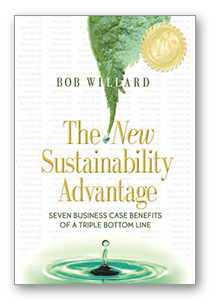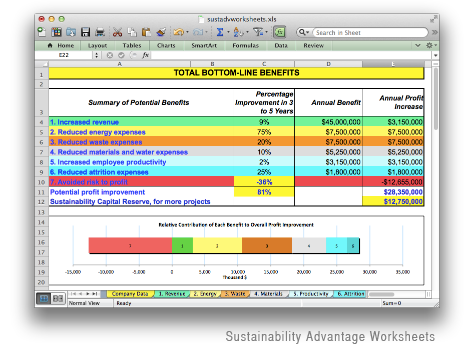 Proactively incorporating sustainability into a business’ core strategy can increase profits by 51 to 81%, according to corporate sustainability expert and author Bob Willard. His book The New Sustainability Advantage and the companion online tools lay out seven strategies and estimate potential returns.
Proactively incorporating sustainability into a business’ core strategy can increase profits by 51 to 81%, according to corporate sustainability expert and author Bob Willard. His book The New Sustainability Advantage and the companion online tools lay out seven strategies and estimate potential returns.
Both sustainability professionals and corporate executives can use this book to help develop their business strategy. Whether you are in a manufacturing business with large factories and complex logistical operation or a consulting firm, each business can get different values from the book. It would be useful for the reader to have an organization and business setting in mind and use it as a lens in relating to the information in the book.
The book focuses on using seven sustainability strategies to increase revenue, improve productivity, reduce expenses, and decrease risks. The seven areas of focus are:
- Increased Revenue & Market Share
- Reduced Energy Expenses
- Reduced Waste Expenses
- Reduced Material & Water expenses
- Increased Employee Productivity
- Reduced Hiring & Attrition Expenses
- Reduced Risks
Cited as a real life example in the book and in a blog post, the Cambridge Ontario based metal fabricating company VeriForm achieved 58% reduction in electricity usage, 90% reduction in natural gas usage which led to 115 tonnes of reduction CO2 emissions reduction, ultimately leading to an increase in profit by 76%. The company had invested $46,186 and yielded energy savings of $89,152 with an average payback period of 6.3 months.
Before reading the book, I would suggest readers to take a look at the companion online Sustainability Advantage Dashboard and download the Sustainability Advantage Worksheets (Excel). They are both free and provide estimates of the potential benefits from implementing the sustainability strategy.

The Dashboard and Worksheets provide data profiles of four sample generic companies as starter sets. The reader can then substitute real life data from his company (e.g. annual revenue, utility expenses, number of employees, staff payroll information) into the Dashboard and Worksheets, if they are available. See the Dashboard in action in this five minute video. Potential benefits are estimated in the seven areas mentioned above and further itemized to specific consumption areas. For instance, energy consumption is divided into lighting, heating and cooling, employee behaviour, etc. Users can estimate percentage improvement through simple retrofitting of existing lighting to energy efficient lighting and how that impacts company’s profit. Using the worksheet users can examine each benefits area in detail, add additional expected benefits, and make assumptions that best meets the company’s situation for improvement. The language of the benefits, the assumptions, and the calculation formulas can all be modified for his actual company.
For those who don’t have time to read or don’t enjoy reading, I would suggest them to subscribe to the book’s companion Slide Sets. A small subscription fee is needed to gain access to the approximately 500 to 600 slides. They include a summary of information from the book, as well as the author’s experience and research. The contents are updated with fresh information every quarter with the latest development in corporate sustainability.
Author Bob Willard opines that sustainability is a step-by-step process and those businesses that are insightful and shrewd will not wait but proactively establish sustainability as part of their core business strategy while those businesses that delay will be trapped in the hoax of an unsustainable business model. He further argues that if done correctly typical companies can raise their profits ranging from 51% to 81% by implementing sustainability strategy. His book and the companion tools are a good place to get this journey started.
